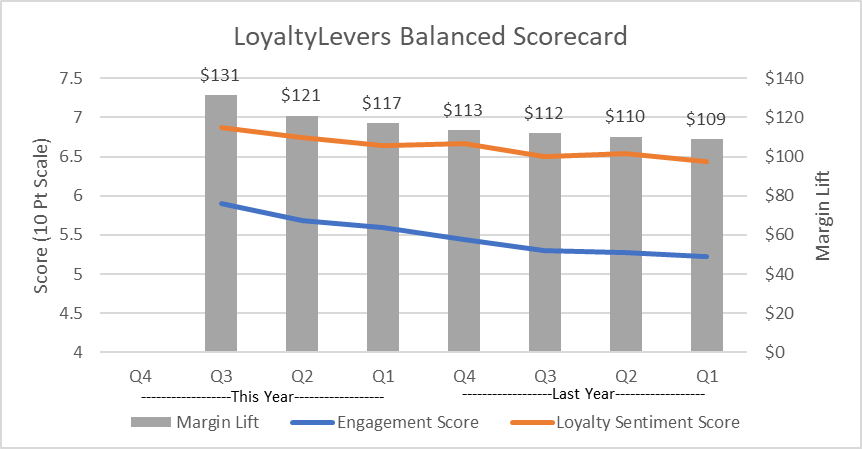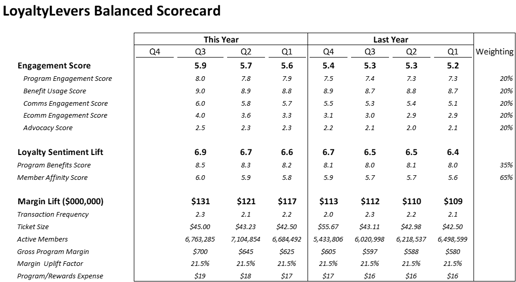LoyaltyLevers Balanced Scorecard: Measuring Loyalty Sentiment
As noted in Loyalty Measurement: C-Suite Needs a Balanced Scorecard, executives need a balanced presentation of...
Ask your loyalty program owner to report out on their program results, and you might hear answers like “It’s hard to measure ROI”, “Redemptions are improving” or “Total revenue is up!”. This article is written especially for the busy CEO, CFO or CMO who wants a reliable yardstick, and it outlines the LoyaltyLevers Balanced Scorecard which provides a unique solution to measurement and optimization.
Granted, it’s hard to measure loyalty program ROI, due to a challenge in establishing causality. Marketing analysts commonly use control groups are used to measure ROI, comparing results for those who received a program (test group) to those who did not (control group). Since most loyalty programs are broadly promoted and available, that is a challenging approach because the better customers will naturally find it valuable to participate. Beware of comparisons of member vs non-member stats because they suffer from this same kind of self-selection bias.
Comparing purchase patterns prior to program introduction vs after program introduction can be a useful approach, especially if your program is recently launched or in the planning stages. It’s less helpful if you are looking to measure and optimize a program introduced 10 or 20 years ago.
Surveys measuring loyalty program perceptions, share of wallet and brand attitudes are also helpful, but lack the critical ROI component. Similarly, program stats such as redemption rates, % of revenue and total membership are important indicators, but cannot provide the full picture.
The LoyaltyLevers Measurement Matrix provides a balanced scorecard, which overcomes the deficiencies of relying on any single measure to gauge program performance. As noted in the Harvard Business Review’s groundbreaking piece on Balanced Scorecards “senior executives do not rely on one set of measures to the exclusion of the other. They realize that no single measure can provide a clear performance target or focus attention on the critical areas of the business. Managers want a balanced presentation of both financial and operational measures”.
Each of the Levers is represented with a key metric, which together provide a holistic view of program performance. After all, behavior without sentiment is merely habit, while sentiment without action is nothing more than goodwill. And without engagement, loyalty programs deliver little incremental impact. Further, this Scorecard provides strong diagnostic power to guide future program strategies.

For example, you may initially see good loyalty from better customers, however there is little engagement nor behavior change. This is a strong indication that the value proposition and marketing support need to be revisited. On the other hand, you may see strong behavior patterns but little gain in loyalty sentiment – this can be a red flag suggesting that more needs to be done in this important area.
The Balanced Scorecard approach puts results in context, as shown in the example below. Improvement in Margin Lift has improved in the last year, in step with the overall Loyalty Sentiment Score. While lower, the Engagement score has been increasing more rapidly, which may be contributing to the strong Q3 results.

Drilling into the scorecard detail provides further insight into the key drivers of change over time. In this example the rapid increase in Engagement is being driven by Program Engagement (enrollment capture and card usage rates) as well as Comms Engagement (opt-ins, engagement and action rates). Loyalty Sentiment is gaining steadily, and Margin Lift is being driven by an increase in transaction frequency and ticket size in Q3, despite a decrease in the size of the active membership.

LoyaltyLevers Take: Implementing Scorecards Requires Change Management
As also noted in the HBR Article, “What you measure is what you get”. Do not underestimate the inertial power of years spent managing to active membership, customer retention or member vs non-member comparisons. Implementing a Balanced Scorecard approach must be driven from the top as a guiding principle and supported over time with a disciplined approach to regular reporting and thoughtful engagement in the test and learn strategies. Implementing this kind of approach will take 6-12 months, so patience is required. The process should begin with a thorough historical review – there are likely nuggets of insights waiting to be discovered within your data already.
To learn more about the detailed metrics included within each of the three LoyaltyLevers, please see these deep dive articles:
As noted in Loyalty Measurement: C-Suite Needs a Balanced Scorecard, executives need a balanced presentation of...
As noted in Loyalty Measurement: C-Suite Needs a Balanced Scorecard, executives need a balanced presentation of...
Comments